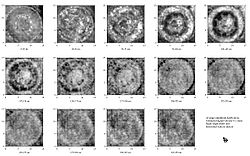
Ground penetrating radar survey is one method used in archaeological geophysics. GPR can be used to detect and map subsurface archaeological artifacts, features, and patterning. GPR depth slices showing a crypt in a historic cemetery. These planview maps show subsurface structures at different depths. Ground Penetrating Radar for Archaeology Sampling and excavating proves timely and costly.

Ground-penetrating radar (abbreviated as GPR) is a technique used in geophysics to collect and record information about the earth’s subsurface. Archaeologists have employed this technical procedure for many years and it is also common in other scientific fields such as geology, environmental studies, and even engineering. Ground - penetrating radar (GPR) stands out from all the available geophysical methods as the only one that provides true depth information. Recently, Product Marketer Ken Corcoran sat down to interview archaeologist Peter Leach, a technical trainer at GSSI, on the best way to use GPR for archaeology. GPR in Archaeology Collecting, processing and interpreting ground - penetrating radar GPR.
Larry is a professor in the Department of Anthropology at the University of Denver. The concept of radar is familiar to most people. The technique’s ability to work over most surfaces and within buildings means GPR is often the only effective geophysical survey option. It was the last day of an eight-day project using ground - penetrating radar to search for unmarked graves in a cemetery. The day didn’t really involve any geophysical surveying as such – all that had been done over the preceding week.
Use of ground penetrating radar to map subsurface archaeological features in an urban area. A ground penetrating radar survey was performed in a small area located near the Messina harbor, northeast Sicily, with the aim of discovering the presence of archaeological remains. The next generation of ground penetrating radar with step frequency, ultra wide band GPR.
Deeper penetration, high resolution at all depths. Ground - Penetrating Radar (GPR) is the process of sending radiowaves through the ground. As these radiowaves pass through the ground , any change in the subsurface materials will cause some energy to be reflected back to towards the surface while the remaining energy continues deeper.
FREE Shipping on eligible orders. We use cookies to distinguish you from other users and to provide you with a better experience on our websites. Walnut Creek (CA): Alta Mira.
In this successor volume, Conyers succinctly and clearly lays out for archaeological practitioners the theory behin and applications of, ground - penetrating radar as a non-invasive method of subsurface prospection. High-speed NDT technologies such as ground - penetrating radar , infrared thermography, and impact echo scanning have been increasingly used in recent years for bridge deck condition assessment. North American archaeology saw early interest in ground - penetrating radar and produced several of its key practitioners,. If you have any other questions, please.
The ground penetrating radar survey was conducted in the streets of Port Royal and in other areas of the city. The public gave considerable attention to the GeoModel, Inc. Archaeology and the cultural heritage field can greatly benefit from reliable and non-destructive analysis to map areas and structures present in the subsoil without the need for excavation.
GPR survey due to the importance of the archaeological mitigation study. Compact and lightweight ground penetrating radar. Archaeologists in Norway using ground - penetrating radar have detected one of the largest Viking ship graves ever found. Archaeology can only benefit from this type of technology, helping us to learn more about ancient cultures today. A concise and easy-to-read summary of all the latest and crucial aspects of ground - penetrating radar uses and data collection, analysis, and processing for archaeological mapping and exploration.
Commercial ground penetrating radar systems cost tens of thousands of dollars. Increase Lapham re-enactor to demonstrate 19th Century surveying while in character. Continue collecting GPR data within survey area. Use soil probe to “ ground truth” significant anomalies. Is it possible to locate artifacts with ground penetrating radar if they only contrast slightly with the surrounding soil?
Joe Nigro, who works at Goddard through Science Systems and Application Inc. NASA satellite data and ground penetrating radar (GPR) technology to map and protect areas of archaeological interest for an excavation project, located at the famed spot. A common application for GPR is that of cemetery investigations and mapping. This is a very common question.
Such investigations may include grave consolidation (searching for free plot allocations), headstone realignment, or general site characterisations. Holding degrees in both geology and anthropology, with a focus on archaeology , his field experience has taken him around the world on hundreds of projects, many of which are used as examples in this book. He is the author of four previous books on the ground - penetrating radar method and its interpretation. T- Archaeology studies in southern Arizona using ground penetrating radar.
Archaeology involves surveying, excavation and analysis of collected materials to learn more about the past. And over the years, GPR has been a great help to archaeologists when it comes to surveying archaeology sites non-destructively and remotely. Wessex Archaeology recently conducted a geophysical survey at St. John’s Church in Bemerton, a mile or so west of Salisbury, Wiltshire.

In this instance, the radar signal - an electromagnetic pulse - is directed into the ground. NASA Earth Scientists Advance Space Archaeology. In the past, NASA radar has been used on.
Pretty shallow earth geophysics pictures and technical discussion relating to the field of archaeology. Rather than buy a loft conversion for my lovely and long suffering wife, Merryn, I have.
Hiç yorum yok:
Yorum Gönder
Not: Yalnızca bu blogun üyesi yorum gönderebilir.